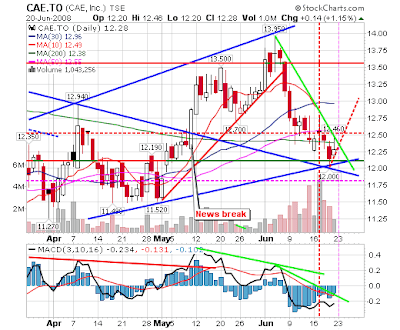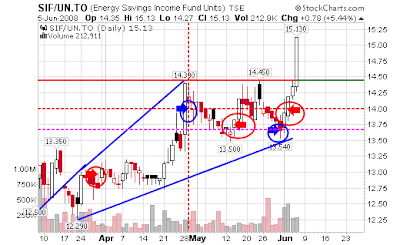Well, I've had 8 weeks worth of trial now with the CTP plan. I think that the realized gain of over 5% isn't too bad...my paper gains are just over 8%. About 4% off my goal. I haven't checked today but I think I may be up a hair in the paper gains department.
Annualized those are 30% and 48% respectively, nothing to sneeze at but far enough from where I expected to be at this point to warrant a review.
I figure that it is time to adjust what I am doing. In the past my plan trials have lasted about 2 weeks maximum as it was usually apparent that the consistent gains were not achievable or the time spent getting the gains was overwhelming...or the plan just plain lost more money than it gained. At least this plan has proved itself worthy of a few adjustments.
STEP 1
Reduce the complexity of the plan
I have been aiming for five types of trades and have only got up to the first three.
- short sell for the downtrend
- long position for the uptrend
- long position counter trend
- short sell counter trend
- long position trade for a long term trade
I figure that reducing the number of trade types that I am looking for and trying will allow me to concentrate on maximizing the potential returns on the active trades before adding the others back in. This pares me back to the typical swing trade styles of short selling and long buying with the trends. I may dabble with the odd longer term buy and hold style should the stock warrant it but all three other counter trend trades are off my list, generally speaking. The fact that a counter trend trade is statistically less probable to produce consistant returns is one good reason to drop them for now, but it is a position trade more than anything so it will have it's use and will stay in my list.
Should the returns meet or exceed my goal then I may stick with this style for a while. Although I like to play so I can't see that happening for very long.
Step 2
Improve the return of the trades
This is something that I decided over the weekend that I needed to do. Looking back at my trades I see some inadequacies that relate directly to my stop settings. My picks are generally good ... statistically speaking ... I just need to remain in the trade longer. The only way to accomplish this is by changing the stop setting rules which I have already mentioned more than once in previous posts. While I find that I am changing stops earlier than I should be it is because I have no firm rules guiding my stop setting, just general ideas where they maybe should be.
Changing the stop setting rules doesn't just mean to leave a larger margin initially. My initial stop has typically been OK if my entry was good. it's the stop movement along the life of the trade, getting stopped out early costs at least $0.50 on the trade profits if it was a spike in price as the price settles back into it's trend quickly and any chance to grab it at a better price is gone.
Rules Rule.
Step 3
Reduce the time spent managing the plan
This is a tough one for me.
I try to nail entries to gain the extra few cents edge or study the charts to find the perfect entry point int he first place. These take time. Nailing the trade entry is not as important as it seems at the time. Over the course of a $3 target, $0.10 really doesn't matter. More use of market orders and either setting orders for market open or at 10am or so will be the next plan.
I expect that I should be able to execute trades, manage stops and check imminent trade charts in 1/2hr per day. This assumes that I have the real work done on the weekend over perhaps a 2 hour period. That would include finding a few more stocks to put on my list, charting a few more to have them ready to trade by for the week, adjusting already charted ones that need adjusting. Cutting out three of the five trade types will reduce research time somewhat.
So that amounts to about 5 hours over the course of the week. I know buy and holders will say they spend far less than this over the same period and that I would have to continue trading in order to make money...perhaps. I cannot justify the possible swings that, as buy and holder, I would have to go through to see a gain over the long term. Realized gains now translate into money re-invested now increasing the compounding effect on the rate of return...or being skimmed to put into use in other ways. I like trading, it has become my new hobby this year and depending on how successful I am it may just be a nice income source to help pay for those toys that I need for my other hobbies. So I don't mind justifying the time spent on the trading plan thus far.
I'll update my stats this evening.
JD.







 Note the following points - history:
Note the following points - history:














